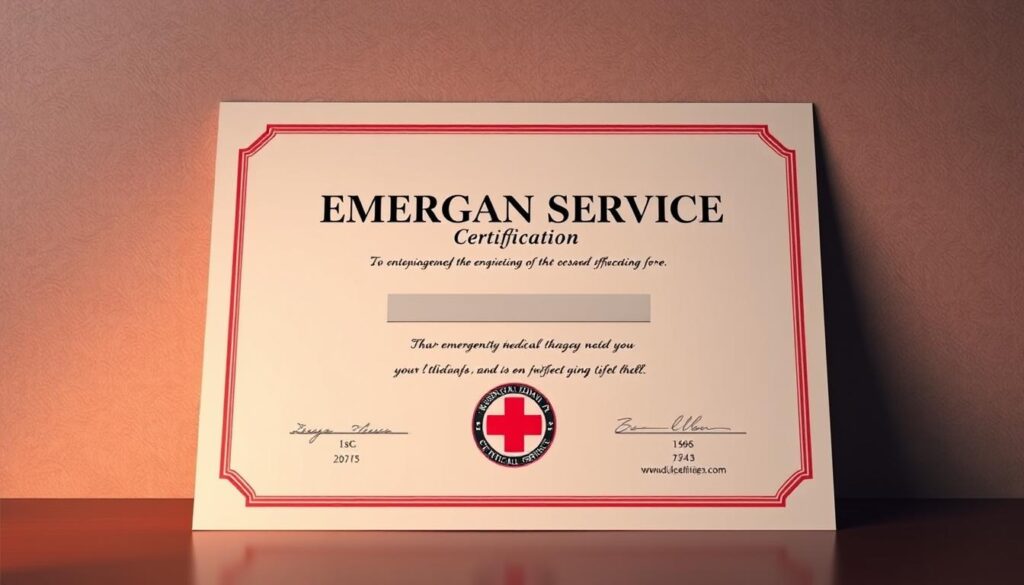Every year, thousands of lives are saved by emergency medical technicians (EMTs). They are trained to handle emergency situations. If you’re thinking about a career in healthcare, starting an emergency medical technology course is a great first step.
By becoming an EMT, you’ll learn to deal with emergencies like cardiac arrests and traumatic injuries. This not only boosts your career but also lets you know you’re saving lives.
Key Takeaways
- Learn life-saving skills through comprehensive training.
- Enhance your career prospects in healthcare.
- Gain the ability to respond to various emergency situations.
- Make a difference in your community.
- Develop skills that are in high demand.
Understanding Emergency Medical Technology
Emergency Medical Technology (EMT) is key in healthcare. It offers quick care in emergencies. As you learn about EMT, you’ll see how it connects emergency care to hospital treatment.
What is Emergency Medical Technology?
EMT is about the training and expertise for emergency response. An EMT checks a patient’s condition, gives the right care, and takes them to a hospital if needed. The emt training program teaches you to handle emergencies like heart attacks and injuries.
The Role of EMTs in Healthcare
EMTs are crucial in healthcare, giving pre-hospital care in emergencies. By joining an emergency medical technician course, you start a career that saves lives. It’s a rewarding job that makes a big difference in people’s lives.
Benefits of Pursuing an Emergency Medical Technology Course
Emergency Medical Technology training is a great way to start a rewarding career in healthcare. By joining an emergency healthcare training program, you learn to handle medical emergencies. You also open doors to many career paths.
Career Opportunities in Emergency Medical Services
After finishing an Emergency Medical Technology course, you’ll have many career options. You can work as an EMT in ambulances or in hospitals and fire departments. With more training, like a paramedic certification course, you can move up in your career.
Personal and Professional Growth
This training gives you medical skills and helps you grow personally and professionally. You’ll improve your critical thinking, problem-solving, and communication skills. These skills make you very valuable in healthcare. This growth can lead to more job satisfaction and chances for advancement.
Prerequisites for EMT Training Programs
To become an EMT, you must meet certain requirements. These include educational, physical, and background checks. These steps help prepare you for emt classes and work in emergency services.
Educational Requirements
Most emt training programs ask for a high school diploma or equivalent. Some might also want you to have taken certain science classes like biology or health.
Physical and Medical Requirements
EMT work is tough, so you need to be physically fit. You might need to pass a physical exam or show you can do tasks that need strength and endurance. You also need to be in good health to handle the challenges of first responder training.
Background Check and Other Considerations
EMT training programs often require a background check. This is because you’ll be working with people who are vulnerable. You also need to be at least 18 and have a valid driver’s license.
Types of Emergency Medical Technology Courses Available
If you’re thinking about a career in emergency medical services, it’s key to know the training options. Emergency medical technology has various courses to prepare you for different roles in emergency response.
Basic EMT Certification Programs
Basic EMT certification programs are the starting point for emergency medical training. These programs teach the basic skills needed for medical emergencies. You’ll learn about patient assessment, trauma care, and medical transport. Completing a basic EMT course prepares you to give critical care in emergencies.
Advanced EMT Training
Advanced EMT training is for those wanting to improve their skills. It covers more complex medical procedures like IV therapy and medication administration. This training lets you provide more advanced care in emergencies, making you a key member of any emergency team.
Paramedic Certification Courses
Paramedic certification courses are the top level of EMT training. As a paramedic, you’ll learn advanced life-support skills, like reading ECGs and managing serious trauma. Paramedic training is for leadership roles in EMS and is a big step for career advancement.
| Course Type | Description | Skills Learned |
|---|---|---|
| Basic EMT | Fundamental training for emergency medical responders | Patient assessment, trauma care, medical transportation |
| Advanced EMT | Intermediate training for complex medical procedures | IV therapy, medication administration, advanced patient care |
| Paramedic | Advanced training for leadership roles in EMS | Advanced life-support skills, ECG interpretation, complex trauma management |
Knowing the different emergency medical technology courses helps you pick the right path for your EMS career goals.
How to Choose the Right EMT Training Program
Choosing the right EMT training program can be tough. There are many options out there. To make a good choice, think about a few important things. These will affect your learning and your future in EMS.
Accreditation and Program Quality
First, check if the program is accredited. Look for the seal of approval from groups like the Commission on Accreditation of Allied Health Education Programs (CAAHEP) or the Accreditation Council for Continuing Medical Education (ACCME). This means the program meets high standards for EMS education.
Course Duration and Schedule Flexibility
Think about how long the program lasts and if it fits your schedule. Some programs are full-time or part-time. Others have classes in the evenings or weekends. Pick one that works with your life and how you learn best.
Cost and Financial Aid Options
Look at the program’s cost and see if there’s financial help. Prices can really vary. Look for programs that offer scholarships or grants to help with the cost.
| Program Features | Program A | Program B | Program C |
|---|---|---|---|
| Accreditation | CAAHEP | ACCME | CAAHEP |
| Course Duration | 12 weeks | 6 months | 3 months |
| Cost | $1,500 | $2,000 | $1,200 |
When deciding, listen to what experienced EMTs say.
“The right EMT training program can make all the difference in your career. Look for programs that offer hands-on training, experienced instructors, and a curriculum that aligns with your career goals.”
By looking at these factors, you can pick a program that will help you succeed in EMS.
Step-by-Step Guide to Enrolling in an Emergency Medical Technology Course

Enrolling in an Emergency Medical Technology course might seem hard. But, breaking it down into simple steps makes it easier. To begin your career in emergency medical services, you need to go through the enrollment process well.
Researching Available Programs
Start by looking for EMT training programs near you or online. Find ones that are accredited and match the certification you want. Think about the program’s length, cost, and if it fits your schedule.
Completing Application Requirements
After finding programs, check their application needs. You’ll likely need to fill out a form, show your educational background, and pass a background check. Make sure you know the deadlines and any fees.
Securing Financial Support
Look into financial aid, scholarships, and payment plans to lower your EMT training costs. Many schools help students who qualify.
Preparing for Your First Day
Get ready for your first day by getting any needed books, gear, or uniforms. Know your course schedule and any pre-course work or orientation.
By following these steps, you’ll smoothly start your EMT training. This will help you succeed in your emergency medical services career.
“The key to a successful EMT career is not just completing the training, but being prepared for the challenges that come with it.”
What to Expect During Your EMT Training
Your EMT training will be a journey of learning. It mixes classroom lessons, hands-on practice, and real-life experience. Knowing what to expect is key to making the most of this experience.
Classroom Learning Components
In the classroom, you’ll dive into many topics. These include how to assess patients, handle trauma, and manage medical emergencies. You’ll also learn about the legal and ethical sides of being an EMT.
Hands-On Skills Training
Hands-on training is a big part of your education. Here, you’ll practice what you’ve learned. It’s where you’ll get the skills and confidence to work as an EMT.
Clinical Rotations and Field Experience
Clinical rotations and field experience are crucial. You’ll work with seasoned EMTs in hospitals and ambulances. This experience will help you apply what you’ve learned in real situations.
| Training Component | Description | Key Skills Learned |
|---|---|---|
| Classroom Instruction | Theoretical foundation in EMT principles | Patient assessment, trauma care |
| Hands-On Skills Training | Practical application of EMT skills | Airway management, bleeding control |
| Clinical Rotations | Real-world experience in healthcare settings | Patient care, teamwork, communication |
Common Challenges in EMT Training and How to Overcome Them
Starting your journey to become an EMT comes with many hurdles. But, with the right approach, you can beat them. As you go through your emergency medical technician course, you’ll face tests of your knowledge, strength, and willpower.
Academic Challenges
The academic part of EMT training is tough. To tackle this, create a study plan that fits your learning style. Use online tools, join study groups, and ask teachers for help when you need it.
Physical and Emotional Demands
EMT training pushes you hard physically and emotionally. Stay in shape to handle the training’s physical demands. Also, find ways to deal with the emotional strain of this kind of training.
Time Management Strategies
Managing your time well is key to balancing your emergency healthcare training with other parts of your life. Make a schedule that lets you focus on your studies, work, and personal life.
| Challenge | Strategy |
|---|---|
| Academic | Develop a study routine, utilize online resources, seek instructor help |
| Physical and Emotional | Stay physically fit, develop emotional coping mechanisms |
| Time Management | Create a schedule, prioritize tasks, maintain work-life balance |
Preparing for EMT Certification Exams

To become a certified EMT, you must pass a tough certification exam. Preparing well is key. Knowing the exam’s structure and content is essential.
National Registry of Emergency Medical Technicians (NREMT) Exam
The NREMT exam is a big step in becoming a certified EMT. It tests your knowledge and skills in emergency care. To get ready for the NREMT exam, do the following:
- Review the NREMT exam outline and content
- Use study materials and practice exams from your training program or other trusted sources
- Work on your weak areas and strengthen your knowledge there
“The key to success in the NREMT exam is thorough preparation and practice.”
State-Specific Certification Requirements
Some states have their own EMT certification rules. It’s important to know these to work as an EMT in your state. Check with your state’s EMS agency for details on certification and any extra exams or certifications.
Understanding the certification process and preparing well will help you pass the EMT exams. Then, you can start your career in emergency medical services.
Maintaining Your EMT Certification
Being an EMT means you must keep your certification up to date. This is key for a successful career in emergency medical services. You need to meet certain education and recertification rules.
Continuing Education Requirements
EMTs must get continuing education hours to keep their certification. These hours keep you current with new medical methods and rules. You can get these hours by going to workshops, seminars, and online courses about emt classes.
This ongoing learning makes sure you’re good at giving emergency care.
Recertification Process
The recertification process asks for proof of your continuing education hours. Sometimes, you also need to pass a recertification exam. Always check with your certifying body for what they need.
By following these steps, you can keep working as a certified EMT without pause. Keeping up with these rules helps you keep your certification. This way, you can keep helping your community.
Advancing Your Career After EMT Certification
With your EMT certification, you open doors to many career advancement opportunities. You can grow your skills and take on new challenges in first responder training and more.
Specialization Opportunities
You can focus on areas like pediatric emergency care, wilderness EMT, or tactical EMT. These specializations boost your skills and make you stand out in the job market.
Pathways to Paramedic and Beyond
Your EMT certification is a key step to becoming a paramedic. Paramedic training includes more in-depth medical emergency response course work. It prepares you for critical care roles.
After paramedicine, you can aim for leadership roles or focus on teaching and training in the EMT field. Advancing your career not only boosts your professional growth but also helps improve emergency medical services.
Conclusion
Starting an emergency medical technology course is a big step towards a fulfilling career. You’ll learn everything you need to be great as an EMT or paramedic. This includes the skills and knowledge to help others in emergency situations.
By picking the right program and getting certified, you’re on your way to making a difference. You’ll be ready to help your community in big ways.
With , you open doors to many career paths. You could work as a basic EMT or move up to a paramedic role. Don’t wait to start a career that truly makes a difference.
FAQ
What is the typical duration of an emergency medical technology course?
The time it takes to finish an emergency medical technology course varies. Basic EMT programs usually last 120-150 hours. Paramedic courses can take up to 1,200 hours or more.
What are the prerequisites for enrolling in an EMT training program?
To join an EMT training program, you need to be at least 18 years old. You must also have a high school diploma or equivalent. A valid driver’s license and meeting physical and medical standards are required too.
How do I choose the right EMT training program for my needs?
When picking an EMT training program, look at several things. Check if it’s accredited and of good quality. Consider the course length, if it fits your schedule, and the cost. Also, see if there are financial aid options available.
What kind of certification can I expect after completing an emergency medical technology course?
After finishing an emergency medical technology course, you can get certified. You’ll be eligible for certification from the National Registry of Emergency Medical Technicians (NREMT) or a state-specific agency.
Are there any continuing education requirements for maintaining EMT certification?
Yes, to keep your EMT certification, you must complete continuing education. The requirements vary by state and certification level. You also need to follow the recertification process.
Can I specialize in a particular area of emergency medical services after becoming certified?
Yes, after getting certified, you can specialize in areas like critical care transport or tactical EMS. You can also work in wilderness EMS, among other options.
What are the career advancement opportunities available after EMT certification?
After getting EMT certified, you can advance in your career. You can become a paramedic or move into supervisory or management roles. You can also specialize in a specific area of emergency medical services.
How do I prepare for the NREMT certification exam?
To get ready for the NREMT certification exam, focus on your EMT training. Review study materials and practice with sample questions and simulations.




